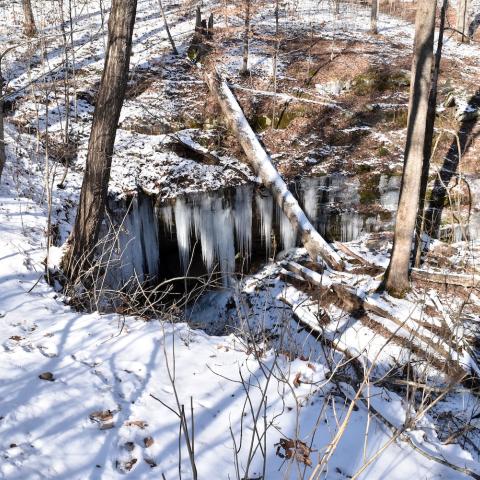
A reconstruction of the new Middle to Late Mississippian ctenacanth sharks from Mammoth Cave National Park and northern Alabama. Glikmanius careforum is seen swimming in the foreground with two Troglocladodus trimblei swimming above/Artwork by Benji Paynose
Two new shark species have been identified through fossilized remains discovered at Mammoth Cave National Park, with the news coming just a handful of months after the park announced another new shark species had been described from fossils there.
“Every new discovery at Mammoth Cave is possible due to collaborations,” said Superintendent Barclay Trimble. “Our park team is honored to work alongside the National Park Service Paleontology Program and now the University of Alabama Geological Sciences Department whose coordinated efforts have made this latest announcement possible.”
The new ctenacanthiform species revealed Thursday were identified as Troglocladodus trimblei and Glikmanius careforum. They were identified by fossils collected from Mammoth Cave in Kentucky and northern Alabama.
Troglocladodus trimblei is a new genus and species of shark that was identified through adult and juvenile teeth found within the St. Louis and Ste. Genevieve Formations of Mammoth Cave and the Bangor Formation in Alabama. The genus name means the “Cave Cladodus” or “Cave Branching Tooth.” It was named in honor of park superintendent Barclay Trimble who found the very first specimen, a single tooth, on an early PRI trip in 2019. The Troglocladodus is estimated to have reached about 10-12 feet in length, or about the size of an oceanic white tip shark.
The second shark, Glikmanius careforum, is a new species of Glikmanius that pushes the origins of this ctenacanth back more than 50 million years earlier than expected. It was identified primarily from teeth in the St. Louis, Ste. Geneveive, and Haney Formations at Mammoth Cave and the Hartselle and Bangor Formations of Alabama, but a partial set of jaws and gills of a young Glikmanius was also found at Mammoth Cave. This set of cartilage fossil was the first of its kind for this genus of ctenacanth shark. The species was named in honor of the Cave Research Foundation that not only supports research at Mammoth Cave, but whose members also discovered the Glikmanius jaws. Glikmanius careforum is estimated to have reached 10-12 feet in length, or about the size of a Lemon Shark. Its jaw shape suggests it had a short head with a powerful bite for hunting smaller sharks, bony fish, and squid-like orthocones.
The two sharks identified would have hunted the ancient near-shore habitats that covered Kentucky and Alabama over 325 million years ago, according to a park release. The area was once an ancient seaway that connected what is now eastern North America, Europe, and northern Africa, but would later disappear as the super continent Pangea formed.
The PRI began in November 2019 when ancient shark specialist John-Paul Hodnett of the Maryland-National Capital Parks and Planning Commission began to work with the NPS Paleontology Program to identify the park’s shark fossils. At least 70 species of ancient fish have been identified at Mammoth Cave from more than 25 caves and cave passages that have been surveyed.
For a detailed overview of the Mammoth Cave National Park PRI, visit Sharks in the dark: Paleontological resource inventory reveals multiple successive Mississippian Subperiod cartilaginous fish (Chondrichthyes) assemblages within Mammoth Cave National Park, Kentucky.
Visit the Shark Photo Gallery for more images of the PRI work at Mammoth Cave National Park.



 Support Essential Coverage of Essential Places
Support Essential Coverage of Essential Places







Comments
Hi - Are these finds and species designations (of the PRI) presented in reviewed journals? I don't see any citations here (maybe I'm missing the link). I see lots of journalist/news articles about these but would like to see the journal citations. I mean - I think this is all great and I love what the Park is doing here, but it may give laymen the wrong idea about how new fossil species are designated. Make no mistake. I am a big fan and I'd love to see your stuff (see here why I'm a good candidate for fandom: Huggins, 1983, "Meramecian conodonts and biostratigraphy of the (upper Mississippian) Greenbrier Limestone (Hurricane Ridge and Greendale Synclines), southwestern Virginia and southern West Virginia," https://vtechworks.lib.vt.edu/items/16d218ee-11e4-4a36-acee-90c814d2b9c2). One of these days I'll get back there (have been a southern Californian for too long!). Regardless of my comment, keep up the great work!
See if this helps:
https://escholarship.org/uc/item/9rz2v701
Follow-up to my earlier comment today. In case of any feedback to my comment, I forgot my email address: michaelhuggins@cox.net
My "bonafides" (as George Clooney said it in "Oh Brother Where Art Thou"): https://www.flickr.com/photos/79475348@N03/albums/72157644301124792/
Thank you, Mike